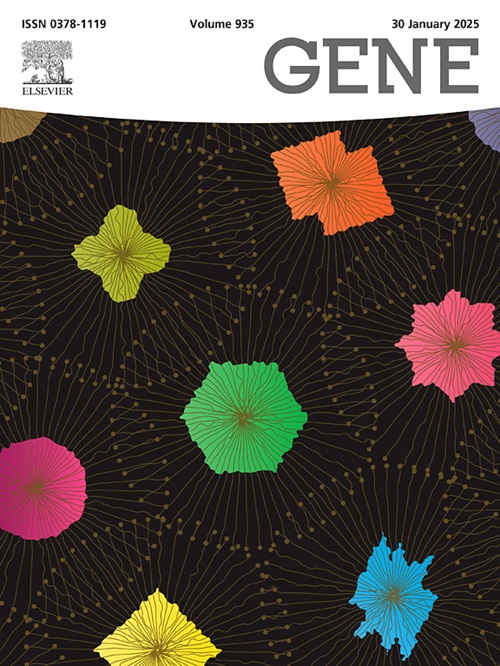lamb1介导的Wnt/β-catenin信号通路促进骨折愈合的内皮血管生成
IF 2.6
3区 生物学
Q2 GENETICS & HEREDITY
引用次数: 0
摘要
目的骨折通常由外伤或骨质疏松症引起,是人类大器官最常见的外伤。骨生成和血管生成是骨折愈合的两个关键部分,它们共同促进受损骨骼的修复和再生。内皮细胞迁移对血管生成至关重要。因此,内皮细胞(ECs)是否能促进骨折愈合非常值得探讨。方法通过scRNA-seq分析公共数据集,并对ECs进行子集分析和伪时间分析。然后,对ECs_Lamb1+细胞进行GO和KEGG通路富集分析,并进行GSVA分析。最后,通过 qRT-PCR、细胞免疫荧光染色和经孔实验对其机制进行了验证和评估。结果经过细胞注释后,得到了 9 种细胞类型,发现 EC 的比例明显降低。EC亚群分析显示,ECs_Lamb1+细胞的比例在骨折组明显上调;伪时间分析显示,ECs_Lamb1-细胞随时间推移逐渐减少,而ECs_Lamb1+细胞则沿轨迹逐渐扩大,在轨迹末端达到最大值;通路富集分析显示,ECs_Lamb1+细胞主要与调控细胞增殖、分化、修复、血管生成和炎症反应的几种信号通路有关,如PI3K-Akt信号通路、Wnt/β-catenin和MAPK。基础实验结果表明,通过 siRNA-LAMB1 成功敲除 Lamb1 的表达不利于 HUVEC 的增殖、迁移和管形成,并可抑制 wnt3a、GSK-3β、β-catenin 和 VEGFA 的表达;而 HY-141873 联合 siRNA-LAMB1 可部分逆转下调的 wnt3a、GSK-3β、β-catenin 和 VEGFA 的表达,并部分改善 HUVEC 的增殖、迁移和管形成。结论Lamb1通过激活Wnt信号通路上调VEGFA表达,催化EC生长和迁移,诱导内皮血管生成,从而促进骨折修复和愈合。本文章由计算机程序翻译,如有差异,请以英文原文为准。
Lamb1-mediated Wnt/β-catenin signaling pathway drives endothelial angiogenesis for fracture healing
Objectives
Fractures, usually caused by trauma or osteoporosis, are the most common traumatic injuries to large organs in humans. Osteogenesis and angiogenesis are two crucial parts of fracture healing that work together to promote the repair and regeneration of damaged bone. Endothelial cell migration is critical for angiogenesis. Therefore, it is well worth exploring whether endothelial cells (ECs) can enhance fracture healing.
Methods
The public datasets were analyzed by scRNA-seq, and the ECs were subjected to subset analysis and pseudotime analysis. Next, ECs_Lamb1+ cells underwent GO and KEGG pathway enrichment analyses, and were subjected to GSVA. Finally, the mechanism was verified and evaluated via qRT-PCR, cellular immunofluorescence staining, and transwell assay.
Results
After cell annotations, 9 cell types were obtained, and it was found that the proportions of ECs were significantly reduced. EC subset analysis showed that the ratio of ECs_Lamb1+ cells was significantly up-regulated in the Fracture group; pseudotime analysis showed that ECs_Lamb1- cells were gradually reduced over time, whereas ECs_Lamb1+ cells were gradually expanding along the trajectories to reach a maximum at the end of the trajectory; pathway enrichment analyses revealed that ECs_Lamb1+ cells were mainly associated with several signaling pathways regulating cell proliferation, differentiation, repair, angiogenesis, and inflammatory responses, such as PI3K-Akt signaling pathway, Wnt/β-catenin, and MAPK. The results of basic assays demonstrated that successful knockdown of Lamb1 expression via siRNA-LAMB1 was detrimental to HUVEC proliferation, migration, and tube formation, and could suppress the expression of wnt3a, GSK-3β, β-catenin, and VEGFA; whereas, HY-141873 in combination with siRNA-LAMB1 partially reversed the down-regulated wnt3a, GSK-3β, β-catenin, and VEGFA expression, and HUVEC proliferation, migration, and tube formation were partially improved.
Conclusion
Lamb1 promotes fracture repair and healing by up-regulating VEGFA expression via the activation of Wnt signaling pathway to catalyze EC growth and migration and induce endothelial angiopoiesis.
求助全文
通过发布文献求助,成功后即可免费获取论文全文。
去求助
来源期刊

Gene
生物-遗传学
CiteScore
6.10
自引率
2.90%
发文量
718
审稿时长
42 days
期刊介绍:
Gene publishes papers that focus on the regulation, expression, function and evolution of genes in all biological contexts, including all prokaryotic and eukaryotic organisms, as well as viruses.
 求助内容:
求助内容: 应助结果提醒方式:
应助结果提醒方式:


